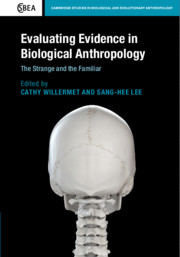Book contents
- Evaluating Evidence in Biological Anthropology
- Cambridge Studies in Biological and Evolutionary Anthropology
- Evaluating Evidence in Biological Anthropology
- Copyright page
- Contents
- Contributors
- Introduction
- Part I The Strange and the Familiar
- 1 Women in Human Evolution Redux
- 2 Hegemony and the Central Asian Paleolithic Record
- 3 Anthropology Now
- 4 The Strangeness of Not Eating Insects
- 5 Methods without Meaning
- Part II (Re)Discovery of Evidence
- Index
- References
1 - Women in Human Evolution Redux
from Part I - The Strange and the Familiar
Published online by Cambridge University Press: 01 November 2019
- Evaluating Evidence in Biological Anthropology
- Cambridge Studies in Biological and Evolutionary Anthropology
- Evaluating Evidence in Biological Anthropology
- Copyright page
- Contents
- Contributors
- Introduction
- Part I The Strange and the Familiar
- 1 Women in Human Evolution Redux
- 2 Hegemony and the Central Asian Paleolithic Record
- 3 Anthropology Now
- 4 The Strangeness of Not Eating Insects
- 5 Methods without Meaning
- Part II (Re)Discovery of Evidence
- Index
- References
Summary
In the history of paleoanthropology, generations of scholars have interpreted and imagined the role of women in shaping the evolution of humanity. Much of this literature about prehistoric women centers on the biologic differences between males and females, which in turn necessitated different evolutionary subsistence and reproductive strategies. When specialization in economic or subsistence production is differentiated by sex, it is typically referred to as a sexual division of labor. The idea that early humans divided their labor by sex is so influential that many believe the human lineage itself could be defined by the singular division between men hunting and women gathering.
- Type
- Chapter
- Information
- Evaluating Evidence in Biological AnthropologyThe Strange and the Familiar, pp. 11 - 34Publisher: Cambridge University PressPrint publication year: 2019
References
- 2
- Cited by



